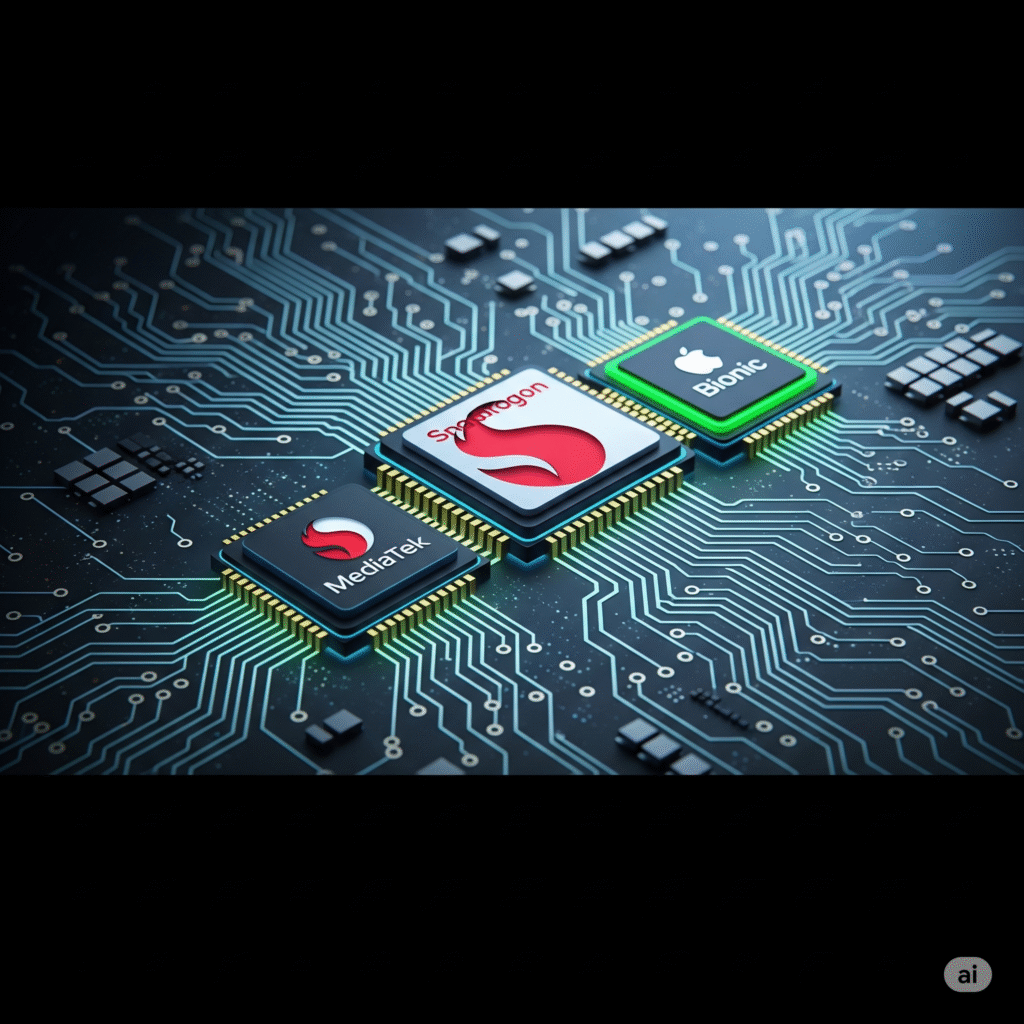
When shopping for a smartphone, most people focus on the camera, screen, or battery life. However, one of the most critical components of any smartphone is the processor, also known as the System on a Chip (SoC). It’s the brain of your device, handling everything from launching apps to processing images and running games. Among the top players in this space are Qualcomm Snapdragon, MediaTek, and Apple’s Bionic chips.
Understanding how these processors differ can help you make more informed choices when buying your next smartphone. In this blog, we’ll break down how these major chipsets work, what sets them apart, and what it means for your daily smartphone experience.
What Is a Smartphone Processor?
A smartphone processor is not just a CPU—it’s a complete system. A modern SoC includes:
- CPU (Central Processing Unit): Handles general tasks and operations.
- GPU (Graphics Processing Unit): Responsible for rendering images and video, especially in games.
- ISP (Image Signal Processor): Processes data from the camera.
- NPU (Neural Processing Unit): Manages AI-related tasks.
- Modem: Handles mobile network connectivity (4G, 5G).
- Other components like memory controllers, audio processors, and sensors.
The quality and efficiency of these components define how fast and power-efficient your phone will be.
Qualcomm Snapdragon
Snapdragon chips are developed by Qualcomm, a U.S.-based semiconductor company. Snapdragon is widely used in flagship and mid-range Android smartphones across brands like Samsung, OnePlus, Xiaomi, and others.
Key Features:
- Adreno GPU: Known for smooth graphics performance in gaming.
- Spectra ISP: Excellent image processing for advanced camera capabilities.
- AI Engine: Provides fast and efficient processing for tasks like voice recognition, photography enhancements, and smart assistant features.
- 5G Support: Snapdragon processors often come with integrated 5G modems, making them ready for the next-gen mobile networks.
The Snapdragon 8-series (e.g., Snapdragon 8 Gen 2) powers high-end devices, while the 7-series and 6-series cater to mid-range and budget phones.
MediaTek
MediaTek, a Taiwan-based company, has significantly improved its reputation in recent years. It used to be considered a budget alternative, but that narrative is changing fast. MediaTek’s Dimensity series now competes directly with Qualcomm’s Snapdragon.
Key Features:
- HyperEngine Technology: Optimizes performance for gaming.
- AI Processing Units: Delivers AI features like scene recognition, facial unlocking, and more.
- Integrated 5G Modem: Ensures power efficiency and improved connectivity.
MediaTek chips are especially popular in Asian markets and are increasingly found in devices from Realme, Xiaomi, and Vivo.
An interesting comparison often made by enthusiasts is dimensity 1200 vs snapdragon 888, two processors that battle in the premium mid-range segment. Both offer impressive specs, but they differ in GPU performance, thermal efficiency, and camera capabilities.
Apple’s Bionic Chips
Apple’s Bionic processors power iPhones and are developed in-house. They are built on ARM architecture like Snapdragon and MediaTek chips but are tightly integrated with Apple’s hardware and software ecosystem.
Key Features:
- Performance + Efficiency Cores: Balances power and battery life using Apple’s custom CPU design.
- Neural Engine: Performs over 15 trillion operations per second for AI tasks.
- Image and Video Processing: Seamlessly integrated with iOS, delivering top-tier photo and video quality.
- Machine Learning Acceleration: Powers advanced features like Face ID, ARKit, and real-time image processing.
Apple’s chips are known for leading in single-core performance, which translates to fast app launches, fluid UI, and long-term software support.
Performance vs. Power Efficiency
While Snapdragon and MediaTek both offer high performance and 5G support, the difference often comes down to thermal management, battery efficiency, and software optimization.
- Snapdragon chips tend to offer better gaming performance and slightly more polished thermal control.
- MediaTek processors often lead in price-to-performance ratio but can sometimes fall short in graphics-intensive tasks.
- Apple’s Bionic chips strike a remarkable balance of power and efficiency due to tight hardware-software integration.
Which One Should You Choose?
- Gamers & Power Users: Snapdragon 8 Gen series or Apple’s latest Bionic chips are the best choices.
- Budget Conscious Users: MediaTek Dimensity or Snapdragon 7-series offer excellent performance at a lower price.
- Photography Lovers: Apple Bionic and high-end Snapdragon processors typically offer superior ISP capabilities.
- General Users: Any recent chip from these three makers will perform well for social media, video streaming, and casual gaming.
The world of smartphone processors is more exciting than ever. Qualcomm’s Snapdragon, MediaTek’s Dimensity line, and Apple’s Bionic chips each bring unique strengths to the table. Whether you’re a gamer, photographer, or just need a reliable phone, understanding how these processors work will help you pick a device that meets your needs.
As mobile technology continues to evolve, these processors will only become more powerful and intelligent, paving the way for even smarter, faster, and more capable smartphones.






